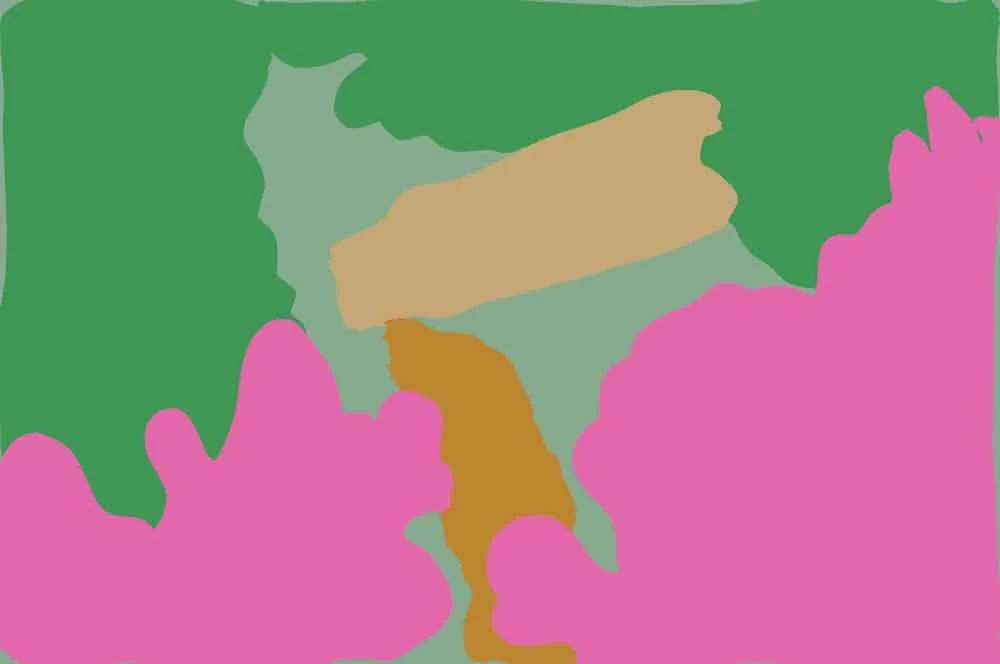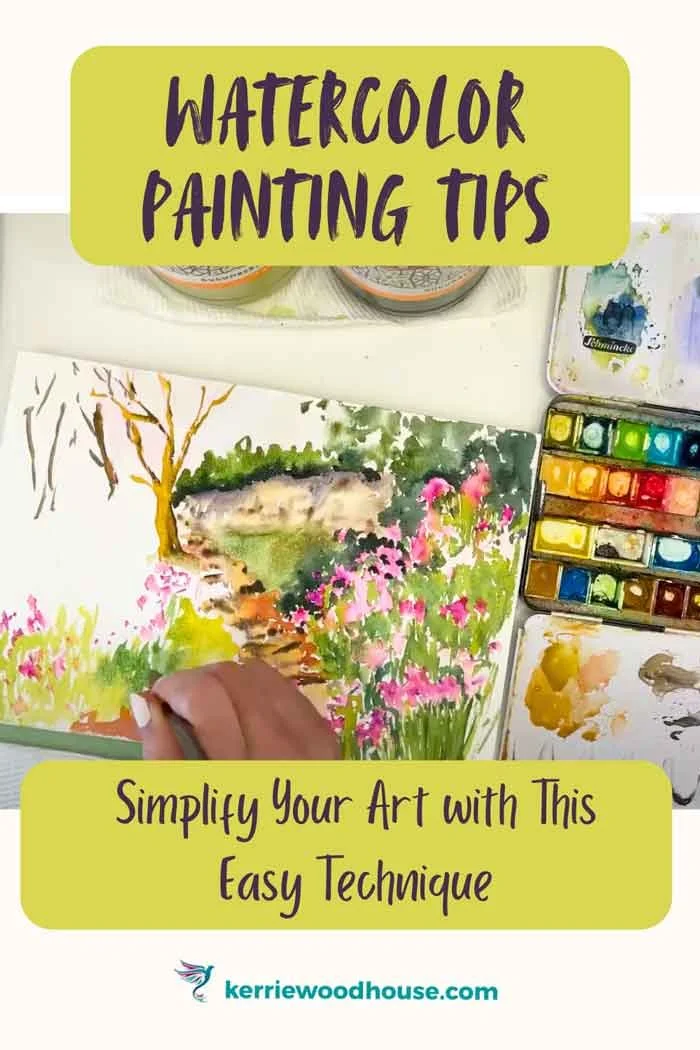How to Simplify Your Watercolour Painting (And Why It Actually Makes It Better)
How do you loosen up your watercolor painting? That's a question I'm often asked, and usually the painter asking that is actually just trying a little bit too hard—because more is not necessarily better.
One of the most helpful ways I know to go about loosening up watercolour painting is to simplify.
Now simplifying is just one tip that will help you loosen up your watercolour painting. If you would like a free guide that gives you ALL my best tips for loosening up your watercolour painting, click here!
Oh, and if you prefer video to reading… scroll down to find the video version 🤗🍿
When a Reference Photo Feels Overwhelming
Let's say you found a charming photo, something that's really inspiring you to paint. And then when you start looking at it, it feels like there's an awful lot going on. There's tons of leaves and tiny little flowers and all those stalks. There's a whole variety of shrubs and trees in the background and a wall. And it just seems like there's so much going on, you don't really know where to start.
I think one of our jobs as painters is to act as filters. We're really filtering out information that we see around us or that we see in a reference of something that we want to paint. It's our job to pick out what we find particularly lovely and focus on that in our painting.
Focus on What You Want, Not What You Don't
So, what exactly do you leave out? Well, I think the way to go about this is possibly to use some of that advice you hear people give to parents of small children where they say, "Don't tell the children what you don't want them to do. Tell them what you do want to do." In other words, when it comes to our painting, let's start by figuring out what are the most important things that we want to get into our image.
Look for Big Shapes First
The way I like to do this is to start by looking for big shapes. What is there in the image that we can group together into big masses that will give us a handful of shapes? So rather than looking for all the little bits and pieces in the image, what are the three to five big shapes that we can see?
Instead of focusing on all the little details and trying to figure out what to leave out, let's just pick the handful of big shapes and work on getting those in as our little pencil sketch—because I don't think you can do a loose painting from a very tight drawing. That's just my opinion and perhaps a story for another day.
Breaking Down a Complex Scene
Here's how I chose to approach this particular image.
When I first look at this picture, the first thing that strikes me is that beautiful frothy tangle of pink blooms, and I see them as two big masses. So that's our first two shapes—there's kind of a collection of them. A nice organic shape, big organic shape in the bottom left and another one in the bottom right.
The other thing I see is a kind of arched shape. Again, it's not perfect neat shapes. They're kind of wiggly organic forms, but it's kind of a big mass of green at the back that's created by the shrubs and trees into the distance. And they're kind of forming a bit of a natural frame, sort of a vignette effect around this whole image. So, that's another shape. Maybe that's our third shape.
And then the main thing we're looking at is this lovely little rough rocky path up to the tree. So there's a wall as well. So maybe the wall is one shape. And again, let's not get worried about the particular little bricks that make up the wall and there's shadows and there's all sorts of things. For now, we're just looking at the big shapes. So there's a big shape of the wall, a big shape made by that little pathway. And possibly we would stick the tree in as an extra shape.
Keep Your Initial Sketch Simple
When it comes to coming up with a little sketch to start off my painting, that's all I'm really looking for—to mark in where those big shapes are going to sit. I don't want to waste too much time with my pencil. I like to switch to my brush as soon as possible and trust that I can do a little bit more drawing effectively with my brush when I get to the painting part.
Wondering how this painting turned out?
Here’s the video version
You're Not a Camera—You're an Artist
In this particular image, there isn't too much that I'm worrying about leaving out necessarily, but I guess it's at this stage that if there was something that I don't need to include, perhaps I've got a photograph that's got a telephone pole in the middle of a landscape and I don't think that's adding, you can feel free to leave it out.
Maybe you've got a sweet little street scene and there's a car parked in the road and you don't want that. Well, you can just leave it out. Maybe there's a car parked somewhere, but actually you want to move it. We can shuffle these big shapes around as it suits us. It's at this point you've got an opportunity to kind of shuffle around the objects in your image. Add some in, take some out, join things together, do whatever suits you to make a lovely looking painting.
Because your job isn't to be another camera. It's not to make a photocopy of exactly what you see. It's to create a charming and entertaining image for the eye and of course to highlight the things that really excited you about this particular image.
The Half-Closed Eyes Trick
If you're looking at the image that you want to paint and you're finding it hard to see the big massed shapes, one of the things you can do is half close your eyes so that you're reducing the amount of information that's going into your brain. What'll happen is you'll see more of the value structure. You'll see just dark shapes and light shapes. And that's ideal because if you can start to see that, you're well on your way to creating a lovely image that's got a good impact for the viewer.
Let Watercolour Do Its Thing
When we start painting, we can tackle one section at a time, one of those big mass of shapes at a time. And sometimes you'll want to leave it really quite abstract. Let the watercolor do its thing and just create lovely washes and textures out of the gorgeous properties of watercolor in those particular areas. And other times you'll want to add a little bit more detail with the brush. Maybe put in a few suggestions of the stems that we can see. But don't worry about trying to capture everyone or trying to put them in exactly the right place.
This is the kind of simplifying that we're talking about. It's not about picking certain key details and choosing to leave them out. It's really just thinking about what things you can suggest in as simple brush strokes as possible.
Other Ways to Simplify
To sum up, my idea of simplifying is not really about leaving out fine details. I don't find that to be particularly helpful advice. Most of the time simplifying is more about figuring out where the big shapes are and using those as a starting point for figuring out where you could simplify your image.
We can also simplify by limiting colors. For example, if in an image like this, there were a whole lot of flowers in that bed and some were slightly different varieties, you could choose to paint them exactly like that. Or you could choose to just simplify it and have all the same variety of flower if that makes things a clearer and cleaner simple image for you. There's no right or wrong answer here. It's simply what your heart would like to paint.
The Magic of Individual Vision
I find it quite fascinating how each of us has our own unique way of distilling the essence of something. It's the reason why many painters can paint the same reference and no two paintings will be the same. I find it a little bit magical to be able to see through the eyes of another in that way.
I really hope that I've given you some good ideas on how you can start simplifying your next watercolor painting so that it enables you to loosen up a little bit more.
Simplifying is just one tip that can help you loosen up your watercolour painting. If you would like a full FREE guide with all my tips on Loosening Up you can download your own copy below 👇
Loosen Up Your Watercolour Painting
7 tips to help you paint with more joy, freedom and expression
We have talked a lot about the practicalities of simplifying the photograph in order to create a loose and lively version of your subject.
But one of the things I have learned after more than a decade of painting is that there is something that you definitely want to AVOID doing if you are aiming for a loose, painterly style.
Are you on your own painting journey?
One of these might be useful…













